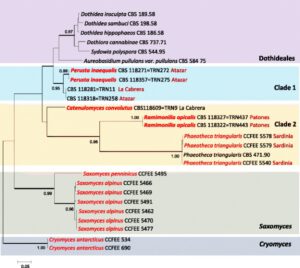Ramimonilia apicalis Stielow & Quaedvl., in Crous, Schumacher, Akulov, Thangavel, Hernández-Restrepo, Carnegie, Cheewangkoon, R; Wingfield, Summerell, Quaedvlieg, Coutinho, Roux, Wood, Giraldo & Groenewald, Fungal Systematics and Evolution 3: 131 (2019)
Index Fungorum Number: IF 829430; MycoBank Number: MB 829430; Facesoffungi number: FoF 11089
Synonym: Ramimonilia apicalis Stielow & Quaedvl., Fungal Diversity 65: 155. 2014. Nom. inval., Art. 40.7 (Shenzhen).
Etymology – Name reflects the typical branched hyphae with apical germination.
Colonies attaining up to 45 mm in diam in 12 weeks, black in reverse, brown and hairy in obverse, pale brown in the center, becoming black near the periphery, with irregular margin. Hyphae pale to dark brown, septate, guttulate, branched, with thick walls, consisting of round and chained cells with apical germination. Teleomorph unknown.
Typus – Spain, Patones, from rock (holotype CBS 118327, culture and specimen preserved as metabolically inactive).
Notes – Two isolates with identical ITS sequences were found to cluster in a separate and external position to the Phaeotheca triangularis clade. This is one of the few species that showed optimal growth rate at 24 °C.

Figure 1- Ramimonilia apicalis CBS 118327 = TRN437. i Colony appearance. j–k Hyphae consosting of chained cells, apically germinating. Scale bars 10 μm

Figure 2 – ITS tree of species of Dothideales: Phaeotheca triangularis, Saxomyces and Cryomyces genera resulting from Bayesian analysis. Bayesian probabilities of ≥95 % are provided above corresponding nodes and in a thicker line. Clades are indicated with colored blocks. In brown text Mediterranean localities are indicated. Strains isolated from rocks are indicated in red text and species described here for the first time in names in red bold text
